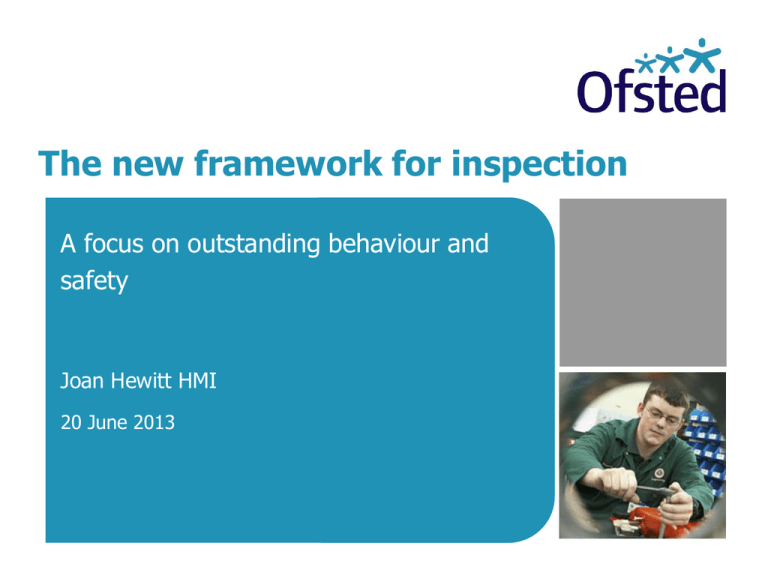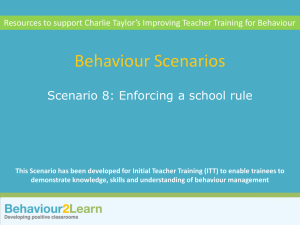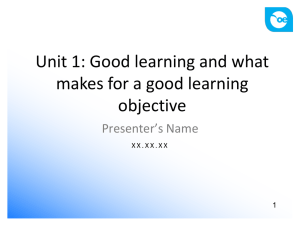
The new framework for inspection
A focus on outstanding behaviour and
safety
Joan Hewitt HMI
20 June 2013
Overview
The new framework - September 2012
The behaviour and safety judgement
Alternative provision
Considerations for your setting
Add presentation title to master slide | 2
Key changes from January 2012
In judging the quality of the school,
inspectors make four key judgements:
achievement
the quality of teaching
behaviour and safety
leadership and management
Add presentation title to master slide | 3
Key changes from January 2012
There is an even greater focus on:
narrowing gaps in performance for groups of
pupils
quality of teaching and its impact on learning and
progress
reading and literacy
behaviour and safety.
Inspectors will expect to use a summary of a school’s
self-evaluation in a form chosen by the school.
Add presentation title to master slide | 4
Key changes from January 2012
Overall effectiveness
This takes account of the four
judgements and how the school
promotes the pupils’ spiritual,
moral, social and cultural
(SMSC) development.
Add presentation title to master slide | 5
From September 2012
The satisfactory grade has been
replaced by ‘requires improvement’
Outstanding (grade 1)
Good (grade 2)
Requires improvement (grade 3)
Inadequate (grade 4)
Add presentation title to master slide | 6
School Improvement
Outcomes, including students’ behaviour and safety
Pastoral
and IAG
support
and
Teaching
and
learning
Leadership and Management
Curriculum
Behaviour and safety
Evaluating behaviour and safety
How good are behaviour and safety in your
school?
How do you know?
How does this relate to the grade descriptors and
the bullet points before them (range of
evidence)?
If you evaluate your pupils’ behaviour as ‘good’,
ask yourself what it would look like if it was not
yet good or how would it need to improve to be
outstanding.
Add presentation title to master slide | 9
Evaluating behaviour and safety
How do you make your judgements? Are you
familiar with the latest:
handbook for inspection, including the grade
criteria
subsidiary guidance
additional guidance on behaviour?
Have you looked at Ofsted’s recent surveys?
(links at the end of this presentation)
Add presentation title to master slide | 10
Evaluating behaviour and safety
Judgements on behaviour and safety
must not be made solely on the basis
of what is seen during the inspection.
Inspectors must take into account a
range of evidence to judge behaviour
and safety over an extended period.
Add presentation title to master slide | 11
Evaluating behaviour and safety
The evidence collected for this judgement
contributes to inspectors’ evaluation of the
school’s promotion of spiritual, moral,
social and cultural development.
Inspectors must take account of the behaviour
and safety of pupils attending off-site,
alternative provision.
Add presentation title to master slide | 12
Evaluating behaviour and safety:
thoughts so far (judgements,
knowledge of documents,
breadth of evidence)?
The range of evidence
Inspectors should consider:
pupils’ attitudes to learning
the school’s analysis of, and response to, pupils’
behaviour in lessons over time, for example incident logs
and records of rewards and sanctions
pupils’ behaviour in a range of different teaching
groups and settings and their attitudes to staff,
including support and administrative staff, new and
inexperienced staff and supply teachers
Add presentation title to master slide | 14
The range of evidence
rates and patterns of permanent and fixed-period
exclusions. This includes patterns of permanent and fixedperiod exclusions for different groups of pupils; the impact
on behaviour of fixed-period exclusions and the impact
of the school’s work to follow up and support excluded pupils;
the use and impact of internal exclusion; and the typical
behaviour of any pupils who are not in school during
the inspection
pupils’ respect for, courtesy and good manners towards each
other and adults, and pride in themselves and their school
Add presentation title to master slide | 15
The range of evidence
types, rates and patterns of bullying and the effectiveness
of the school’s actions to prevent and tackle all forms of
bullying and harassment – this includes cyber-bullying and
prejudice-based bullying related to special educational
need, sexual orientation, sex, race, religion and belief,
gender reassignment or disability
the effectiveness of the school’s actions to prevent and
tackle discriminatory and derogatory language – this
includes homophobic and racist language, and language
that is derogatory about disabled people
Add presentation title to master slide | 16
The range of evidence
the views expressed by pupils, and different groups of
pupils, of their experiences of others’ behaviour and
attitudes towards them
the views of parents, staff, governors and others
the school’s response to any extremist behaviour shown by
pupils
the extent to which pupils are able to understand and respond
to risk, for example risks associated with extremism[1]
[1] This includes risks associated with e-safety, substance
misuse, knives and gangs, relationships (including sexual
relationships), water, fire, roads and railways.
Add presentation title to master slide | 17
The range of evidence
overall and persistent absence and attendance rates for
different groups – attendance figures alone should not
determine the judgements for behaviour and safety
punctuality over time in arriving at school and at lessons
and the impact of the school’s strategies to improve
behaviour and attendance – this includes the use of
rewards and sanctions, the effectiveness of any additional
on-site provision to support behaviour, work with parents
and absence ‘follow-up’
the number of pupils taken off roll in the last year as a
result of factors related to behaviour, safety and
attendance.
Add presentation title to master slide | 18
Off-site alternative provision
Alternative provision
The use and effectiveness of alternative provision
has a high profile in the September 2012 section 5
inspection framework.
‘Inspectors must evaluate the robustness with which the
school monitors the attendance, behaviour, learning and
progress of pupils that receive alternative provision.’
Initial phone call: establish whether the school has any
pupils who attend off-site alternative provision either on a
full- or part-time basis.
School to have ready at start of inspection: details about
the school’s use of alternative provision.
Add presentation title to master slide | 20
Alternative provision
Evaluating learning: consider the school’s own records
of pupils’ progress, including the progress of pupils who
attend off-site alternative provision for all or part of the
week.
Inspectors must take account of the behaviour and
safety of pupils attending off-site, alternative provision
Grade descriptor for outstanding behaviour: ‘All groups
of pupils feel safe at school and at alternative provision
placements at all times.’
Safeguarding: ….the care taken to ensure that pupils
placed in alternative provision are safe at all times.
Add presentation title to master slide | 21
Alternative provision
The outcomes and provision for pupils attending
alternative placements remain fully the
responsibility of the school.
Considerations for inspectors:
how the school identifies appropriate
provision so that it will match a pupil’s
needs and interests as well as enable them
to gain knowledge and skills
how the school initially, and on an ongoing
basis, assesses the quality and safety of
the provision
the quality of information that the school
gives to the provider, for example about the
pupil’s special educational needs, behaviour
or literacy levels
Add presentation title to master slide | 22
Alternative provision
how the school monitors and evaluates
pupils’ progress, attendance and behaviour and
intervenes and supports as needed
the progress that pupils are making while
attending alternative provision
whether any qualifications being taken are at
the appropriate level
the quality of the pastoral support that pupils
are receiving while attending provision off site.
NB - The school’s monitoring of attendance is an
important part of its safeguarding
responsibilities
Add presentation title to master slide | 23
Alternative provision
Survey report - Alternative
Provision, Ofsted 2011
http://www.ofsted.gov.uk/resources/alt
ernative-provision
Add presentation title to master slide | 24
Alternative provision
Section 5 report extract:
A number of students attend alternative provision for part of
each week. Their achievement is good because of the highly
tailored programmes that motivate them to attend more
frequently. The link mentors ensure students’ achievement is
closely monitored and any barriers are addressed swiftly. As a
result, students’ progress rapidly increases and they gain suitable
functional skills and vocational qualifications, thus helping to
narrow the gap between their performance and that expected for
their age….. Students who attend alternative provision make
significant progress in their ability to take on responsibility and
behave appropriately in a range of situations helping them to
keep safe…… Very regular visits from the students’ mentors
inform a weekly review meeting of the achievement, attendance
and behaviour of every student.
Add presentation title to master slide | 25
Evaluating behaviour and safety:
further thoughts?
Considerations for leaders
Grade descriptors
Behaviour over time, in and out of lessons
Outstanding
Pupils’ attitudes to learning are exemplary.
Pupils’ behaviour outside lessons is almost always impeccable.
Pupils’ pride in the school is shown by their excellent conduct,
manners and punctuality.
Good
Pupils’ attitudes to learning are consistently positive and lowlevel disruption in lessons is uncommon.
There is a positive ethos in the school, and pupils behave
well, have good manners and are punctual to lessons.
Add presentation title to master slide | 28
Considerations
How consistent, and how good, are behaviour
and attitudes in lessons (over time)? How do
you know?
What does your data tell you about behaviour in
lessons for different groups, times of day,
subjects, days of the week, staff? Actions taken?
Impact?
Does behaviour vary between structured and
unstructured times?
What support do you give to pupils to manage
their behaviour during unstructured times? How
effective?
Add presentation title to master slide | 29
Grade descriptors
The management of behaviour
Outstanding
Skilled and highly consistent behaviour management by
all staff makes a strong contribution to an exceptionally
positive climate for learning.
Good
Behaviour is managed consistently well.
Add presentation title to master slide | 30
Considerations
What does your data show about the behaviour
of groups?
What is your response to this and how effective
has this been?
If exclusion is used, is it effective in changing
behaviour? Is its use reducing?
How consistent are staff at helping to uphold
the school’s expectations of behaviour (conduct,
personal appearance, movement around the
school, language, behaviour in lessons,
interactions with each other)?
Add presentation title to master slide | 31
Evaluating behaviour and safety:
further thoughts? Be your own
inspector, where would you look for
evidence?
Grade descriptors
Views of pupils, parents and staff
Outstanding
Parents, staff and pupils are unreservedly positive about
both behaviour and safety.
Good
There are few well founded concerns expressed by
parents, staff and pupils about behaviour and safety.
Add presentation title to master slide | 33
Considerations
Do you know what pupils think about behaviour
in lessons and other times? Have you taken any
action on the basis of their views combined with
your evidence?
What do different groups of staff think about
pupils’ behaviour and the support they receive
to manage it? TAs? Lunchtime supervisors?
What are parents’ views about pupils’
behaviour and how well incidents are dealt with?
How do you gather these? Actions taken?
Add presentation title to master slide | 34
Grade descriptors
Individual improvements
Outstanding
There are excellent improvements in behaviour over time
for individuals or groups with particular behaviour needs.
Good
There are marked improvements in behaviour over time
for individuals or groups with particular behavioural
needs.
Add presentation title to master slide | 35
Considerations
Improvements in individuals’ behaviour over
time are an important part of the good and
outstanding grade descriptors.
How can you demonstrate the impact of
your strategies to improve the behaviour of
individuals?
How clear is your baseline measure? How
broad is this? How are you tracking against
it?
Demonstration of evidence, not assertion
Add presentation title to master slide | 36
Evaluating behaviour and safety:
further thoughts? Be your own
inspector, where would you look for
evidence?
Grade descriptors
Bullying
Outstanding
Pupils are fully aware of different forms of bullying,
including cyber-bullying and prejudice-based bullying,
and actively try to prevent it from occurring. Bullying in
all its forms is rare and dealt with highly effectively.
Good
Pupils have a good awareness of different forms of
bullying. There are few instances of bullying and these
are dealt with effectively by the school.
Add presentation title to master slide | 38
Considerations
What do pupils think about bullying and the
support they will receive if bullied? Are they
used to expressing their views?
Are your records about bullying clear, with
good analysis? Are actions targeted well?
What contribution does the curriculum make
to preventing bullying and discrimination?
How consistently is discriminatory language
challenged? Racist? Homophobic? Sexist
and sexual?
Add presentation title to master slide | 39
Findings from ‘no place for bullying’
In the best examples in the survey:
the schools’ expectations and rules clearly spelled out how pupils
should interact with each other; respect for individual differences
had a high profile
the curriculum gave pupils a wide range of opportunities to develop
their knowledge and understanding of diversity and an assortment
of strategies to protect themselves from bullying
the schools recorded bullying incidents carefully and analysed them
to look for trends and patterns
they then used this information to plan the next steps. The action
they took was firm and often imaginative
if pupils had been bullied then they felt very confident that action
was taken and it stopped promptly
governors were well informed and questioning about bullying.
Add presentation title to master slide | 40
Findings from ‘no place for bullying’
Pupils in all of the schools (56) gave a range of
examples of derogatory or disparaging language that
they heard during the school day.
In both primary and secondary schools language heard
related to perceived ability or lack of ability, race,
religion, sexuality, appearance, family circumstances,
and, in secondary schools, sexual behaviour.
This evidence from the pupils was in direct contrast with
the views of the staff.
At least some of the staff interviewed in 24 of the
primary schools and seven of the secondary schools
commented that they ‘never’ heard prejudicebased language, such as homophobic or racist
language, or language related to disability, from pupils.
Add presentation title to master slide | 41
Grade descriptors
Safety
Outstanding
All groups of pupils feel safe at school and at alternative
provision placements at all times. They understand very
clearly what constitutes unsafe situations and are highly
aware of how to keep themselves and others safe,
including in relation to e-safety.
Good
Pupils feel safe at school and at alternative provision
placements and understand how to keep themselves
safe.
Add presentation title to master slide | 42
Considerations
How good are the attendance and
punctuality of different groups of pupils?
Actions taken? Impact?
How good are the behaviour and
attendance of any pupils on alternative
provision? Evidence?
How do you know the impact of the
taught curriculum on pupils’
understanding of keeping safe?
Add presentation title to master slide | 43
Considerations
How will you present a succinct
summary of your evidence to inspectors
in advance of the inspection, through
your self evaluation (think analysis
related to available evidence, not
description)
Add presentation title to master slide | 44
Evaluating behaviour and safety:
final thoughts and questions
Important documents
Section 5 inspection handbook, subsidiary guidance,
briefing on ‘additional provision to manage behaviour:
http://www.ofsted.gov.uk/resources/briefings-andinformation-for-use-during-inspections-of-maintainedschools-and-academies
No place for bullying (Ofsted, 2012)
http://www.ofsted.gov.uk/resources/no-place-for-bullying
Alternative provision (Ofsted 2011)
http://www.ofsted.gov.uk/resources/alternative-provision
Add presentation title to master slide | 46
Important documents
The Pupil Premium – how schools are spending the funding
successfully to maximise achievement
http://www.ofsted.gov.uk/resources/pupil-premium-howschools-are-spending-funding-successfully-maximiseachievement
The Pupil Premium – analysis and challenge tools for
schools
http://www.ofsted.gov.uk/resources/pupil-premiumanalysis-and-challenge-tools-for-schools
Add presentation title to master slide | 47
Good practice film - bullying
Secondary
http://www.ofsted.gov.uk/resources/goodpractice-film-hillcrest-school-and-communitycollege-bullying
Add presentation title to master slide | 48


![afl_mat[1]](http://s2.studylib.net/store/data/005387843_1-8371eaaba182de7da429cb4369cd28fc-300x300.png)




